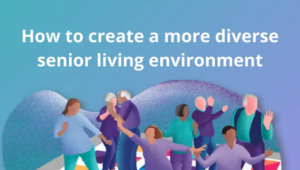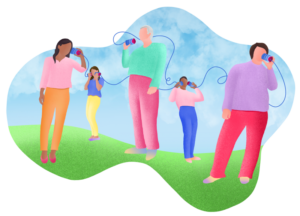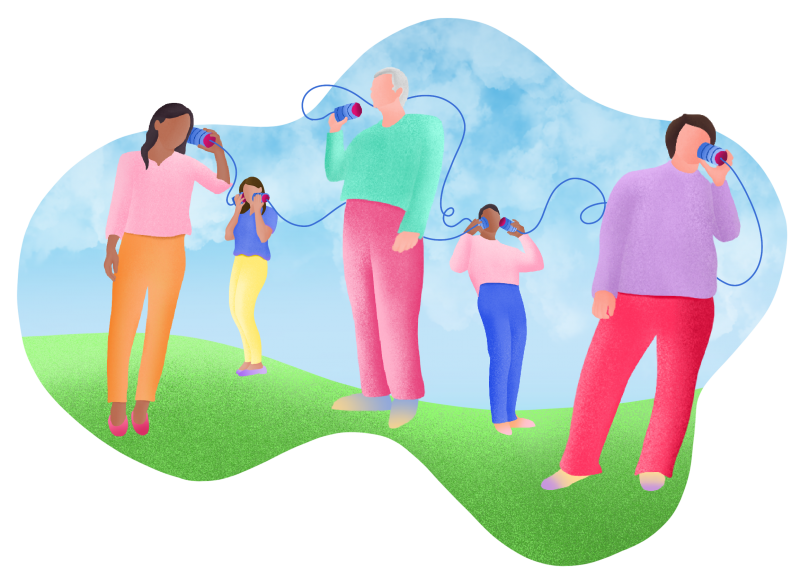How to create a more diverse senior living environment
This article was originally written by Morgan McCoy, Touchtown

Serving the unique individuals who live in senior communities is so much of the reason this industry is incredible. But some voices do not get amplified as much as others, and we need to talk about that.
You may wonder why it’s so important to amplify these voices in senior living.
We cannot promise the best care without first understanding and accepting the unique needs, preferences, and history of diverse older adults. Only when we share, celebrate, and acknowledge the differences of our residents can we truly provide person-centered care.

In diverse communities, access to long term care has increased over the last several decades, creating a great opportunity to develop multicultural programming and more. That being said, some communities typically have more varied access to care that fits their specific preferences, budgets, and needs according to federal nursing home assessment data (Feng, et al.). If all communities made the choice to start taking small steps to a more inclusive environment, we could flip the script.
Here are some of those small ways we can create more diverse senior living communities that serve our residents as best we can.
-
Promote diverse elder voices and stories
We all love a good story. Seniors have just about the best ones.
There are some stories that are told more loudly while others — such as those from communities of color, LGBTQ+, and older adults living with “taboo” illnesses like HIV or AIDS — are not so quick to be told.
These stories matter as much as any others, and we can do more to uplift them. Elevating the stories of diverse older adults may improve the negative emotional impact that come with not feeling like one “belongs.” One reason to be concerned about telling diverse elders’ stories is the emotional impact when humans don’t feel a sense of belonging.
The need-to-belong theory is a well-studied concept in psychology that identifies belonging in social groups and established relationships as a fundamental human need. A recent American Psychological Association (APA) report on this theory states, “Studies of rejection show that thwarting the need to belong produces drastic and sometimes puzzling effects, including increases in aggression and self-destructive acts, and decreases in helpfulness, cooperation, self-control, and intelligent thought” (Baumeister).
This impact on behavior is particularly concerning for diverse older adults and their overall wellness. By encouraging residents to be their whole selves and by facilitating relationships through storytelling, we can start on the road to every individual feeling accepted in our diverse communities.
-
Partner with local culturally competent organizations to expand your programming and services
Culture shapes who we are — our cuisines, traditions, and interests derived from our unique backgrounds are vital to our identity.
Being in a situation where your identity is not appreciated or understood can be difficult, especially for seniors who may experience “culture shock” when they move into your community from their own.
For each resident to really feel recognized as a neighbor in your community, we must expand your cultural programming. For example, ethnic cooking classes may help diverse residents feel more welcomed. Seek out local councils for the diverse groups you serve in your community and strike up partnerships. Go directly to your residents to find out if they want to teach a class on a subject personal to their culture. Have a culture fair. Highlight a different cuisine from a different locale every Friday.
Whatever you do, ensure each person can feel at home by recognizing they may want to have a Latin dance class on top of every weekly yoga class!
-
Create more diverse marketing materials that represent that communities you serve, or want to serve, to appeal to more seniors
Do an audit of your marketing material. Take note of who you are representing in that material. Then, take note of the demographics of your communities and the surrounding areas.
Do they look pretty similar?
We want to see ourselves in the brands and organizations we support. Think with Google, Google’s research arm, recently did a study on how diverse marketing impacts consumer behavior. Here’s what they found:
“64% of those surveyed said they took some sort of action after seeing an ad that they considered to be diverse or inclusive. This percentage is higher among specific consumer groups including Latinx+ (85%), Black (79%), Asian/Pacific Islander (79%), LGBTQ (85%), millennial (77%), and teen (76%) consumers.”
It’s telling that many racial/ethnic and identity groups are more likely to pursue brands that show people like them.
We all want to be seen, heard and understood. Challenge your marketing and sales process to see how it can attract and welcome more diverse residents.
-
Train staff to be culturally competent
A 2000 report from Brach & Fraser shows that cultural competency in healthcare services leads to better outcomes and fewer health disparities among underserved populations.
A staff more representative of the communities you serve and equipped to recognize, empathize, and understand a culturally diverse community will better provide care that promotes the longevity, health, and wellness of their residents.
There are a number of resources that can help staff become more culturally competent. SAGECare, the educational subsidiary of Services and Advocacy for GLBT Elders, provides training that will help your staff meet SAGE/HRC Long Term Care Health Index.
Similarly, the Diverse Elders Coalition will soon be launching their cultural competency curriculum to help improve the multicultural capacities of healthcare, social service providers, and aging-focused organizations to better serve diverse family caregivers.
If you’re not familiar with Touchtown, we’re a technology company that serves hundreds of thousands of seniors across the world. We have seen firsthand the impact of expanded programming and storytelling in our partner communities. We’re so proud of the strides our industry has made in enhancing the lives of older adults and look forward to continuing in this journey with you all. Please feel free to reach out to us any time with your own ideas and stories on uplifting diverse elder voices.
Sources
Baumeister, R. F. (2012). Need-to-belong theory. In P. A. M. Van Lange, A. W. Kruglanski, & E. T. Higgins (Eds.), Handbook of theories of social psychology (p. 121–140). Sage Publications Ltd. https://doi.org/10.4135/9781446249222.n32
Zhanlian Feng, Mary L. Fennell, Denise A. Tyler, Melissa Clark, and Vincent Mor, “Growth Of Racial And Ethnic Minorities In US Nursing Homes Driven By Demographics And Possible Disparities In Options,” Health Affairs 30, No. 7 (2011): 1358-1365.
The opinions expressed in this article are those of the author and do not necessarily reflect those of the Diverse Elders Coalition.



